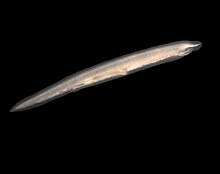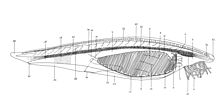
A chordate is a deuterostomic animal belonging to the phylum Chordata. All chordates possess, at some point during their larval or adult stages, five distinctive physical characteristics (synapomorphies) that distinguish them from other taxa. These five synapomorphies are a notochord, a hollow dorsal nerve cord, an endostyle or thyroid, pharyngeal slits, and a post-anal tail. The name "chordate" comes from the first of these synapomorphies, the notochord, which plays a significant role in chordate body plan structuring and movements. Chordates are also bilaterally symmetric, have a coelom, possess a closed circulatory system, and exhibit metameric segmentation.

The Poeciliidae are a family of freshwater fishes of the order Cyprinodontiformes, the tooth-carps, and include well-known live-bearing aquarium fish, such as the guppy, molly, platy, and swordtail. The original distribution of the family was the Southeastern United States to north of Río de la Plata, Argentina, and Africa, including Madagascar. Due to release of aquarium specimens and the widespread use of species of the genera Poecilia and Gambusia for mosquito control, though, poeciliids can today be found in all tropical and subtropical areas of the world. In addition, Poecilia and Gambusia specimens have been identified in hot springs pools as far north as Banff, Alberta.

Tullimonstrum, colloquially known as the Tully monster or sometimes Tully's monster, is an extinct genus of soft-bodied bilaterian animal that lived in shallow tropical coastal waters of muddy estuaries during the Pennsylvanian geological period, about 300 million years ago. A single species, T. gregarium, is known. Examples of Tullimonstrum have been found only in the Essex biota, a smaller section of the Mazon Creek fossil beds of Illinois, United States. Its classification has been the subject of controversy, and interpretations of the fossil have likened it to molluscs, arthropods, conodonts, worms, tunicates, and vertebrates. This creature had a mostly cigar shaped body, with a triangular tail fin, two long stalked eyes, and a proboscis tipped with a mouth-like appendage. Based on the fossils, it seems this creature was a nektonic carnivore that hunted in the ocean’s water column. When Tullimonstrum was alive, Illinois was a mixture of ecosystems like muddy estuaries, marine environments, and rivers and lakes. Fossils of other organisms like crustacean Belotelson, the cnidarian Essexella, and the elasmobranch fish Bandringa have been found alongside Tullimonstrum.

Labrisomids are small blennioids (blennies), percomorph marine fish belonging to the family Labrisomidae. Found mostly in the tropical Atlantic and Pacific Ocean, the family contains about 110 species in 15 genera.

Pikaia gracilens is an extinct, primitive chordate animal known from the Middle Cambrian Burgess Shale of British Columbia. Described in 1911 by Charles Doolittle Walcott as an annelid, and in 1979 by Harry B. Whittington and Simon Conway Morris as a chordate, it became "the most famous early chordate fossil", or "famously known as the earliest described Cambrian chordate". It is estimated to have lived during the latter period of the Cambrian explosion. Since its initial discovery, more than a hundred specimens have been recovered.

The lancelets, also known as amphioxi, consist of some 30 to 35 species of "fish-like" benthic filter feeding chordates in the subphylum Cephalochordata, class Leptocardii, and family Branchiostomatidae.
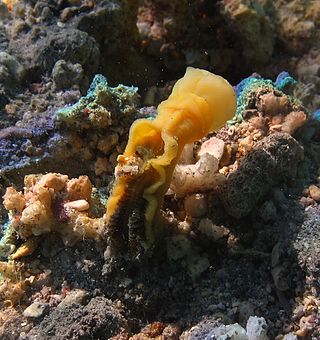
Balanoglossus is a genus of ocean-dwelling acorn worms (Enteropneusta). It has zoological importance because, being hemichordates, they are an "evolutionary link" between invertebrates and vertebrates. Balanoglossus is a deuterostome, and resembles the sea squirts (Ascidiacea) in that it possesses branchial openings, or "gill slits". It has a notochord in the upper part of the body and has no nerve chord. It does have a stomochord, however, which is a gut chord within the collar. Their heads may be as small as per 2.5 mm (1/10 in) or as large as 5 mm (1/5 in).
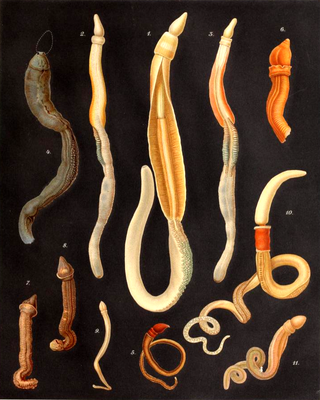
The acorn worms or Enteropneusta are a hemichordate class of invertebrates consisting of one order of the same name. The closest non-hemichordate relatives of the Enteropneusta are the echinoderms. There are 111 known species of acorn worm in the world, the main species for research being Saccoglossus kowalevskii. Two families—Harrimaniidae and Ptychoderidae—separated at least 370 million years ago.

The Terebellidae is a marine family of polychaete worms, of which the type taxon is Terebella, described by Carl Linnaeus in his 1767 12th edition of Systema Naturae.
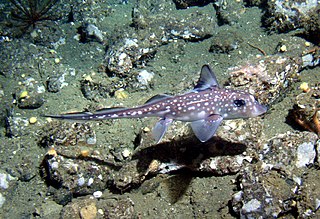
Hydrolagus is a genus of fish in the family Chimaeridae found in the Atlantic, Indian and Pacific Oceans.

The Chimaeridae, or short-nosed chimaeras, are a family of cartilaginous fish.

Metaspriggina is a genus of chordate initially known from two specimens in the Middle Cambrian Burgess Shale and 44 specimens found in 2012 at the Marble Canyon bed in Kootenay National Park.

Ptychoderidae is a family of acorn worms.

Branchiostoma lanceolatum, the European lancelet or Mediterranean amphioxus is a lancelet in the subphylum Cephalochordata. It is a marine invertebrate with a notochord but no backbone and is used as a model organism to study the evolutionary development of vertebrates.
In biology, solenocytes are elongated, flagellated cells commonly found in lower invertebrates, such as flatworms, chordates and several other animal species. In terms of function, solenocytes play a significant role in the excretory systems of their host organism(s). For example, the lancelets, also referred to as amphioxus, utilize solenocytic protonephridia to perform excretion. In addition to excretion, these cells contribute to ion regulation and osmoregulation. With this in mind, solenocytes form subtypes of protonephridium and are often compared to another specialized excretory cell type, i.e., flame cells. Solenocytes have flagella, while flame cells are generally ciliated.
Branchiostoma bennetti, the mud lancelet, is a lancelet of the genus Branchiostoma endemic to the Gulf of Mexico, where it is found in the northern part.
Amphioxus or lancelets (Branchiostoma) are members of the Chordata phylum of which all members have a notochord at some point while they are alive. B. belcheri have a notochord, dorsal nerve cord, pharynx, buccal cavity, cirri, tail, dorsal fin, nerve cord, segmented muscle, and ocelli. They are distinguishable by a slightly round dorsal fin, eighty slender preanal fin-chambers, narrow caudal fin, and obtuse angles between fins. They obtain food by filter feeding. They were first reported in 1897 near the Amakusa Islands, specifically off Goshonoura Island, south of Amakusa-Kamishima Island. These islands are located on the west coast of Kyushu, the island furthest south of the four main isles of Japan. In addition to the location of the siting, information regarding reproductive period and morphology was also obtained. B. belcheri are gonochoric, reproducing via external fertilization. B. belcheri are an endangered species, threatened by the influx of pollutants of land-based origin into the sea such as cleaning agents, chemical waste, garbage, mining waste, pesticides, petroleum products, and sewage.

Branchiostoma japonicum, the Japanese lancelet, is a species of lancelet within the family Branchiostomatidae. The species grows to lengths of 50 to 60 millimeters in length and inhabits waters off the coasts of China and Japan. In Xiamen, the lancelets inhabiting the waters were originally thought to be of Branchiostoma belcheri in 1932, however recent studies revealed B. japonicum is also present in the lancelet populations.
